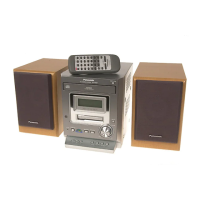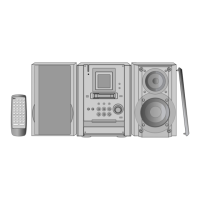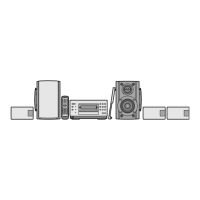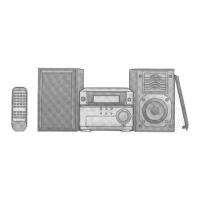What to do if my Panasonic SC-PM50D has no power?
- MMichael RobersonJul 31, 2025
If your Panasonic Stereo System has no power, disconnect the AC mains lead, and then connect it again. Also, let the system dry for 1 to 2 hours.
What to do if my Panasonic SC-PM50D has no power?
If your Panasonic Stereo System has no power, disconnect the AC mains lead, and then connect it again. Also, let the system dry for 1 to 2 hours.
Why is there no sound coming from my Panasonic SC-PM50D?
If there is no sound coming from your Panasonic Stereo System, check the connections first. Ensure that the volume is at an audible level and not muted. Note that a pause in the sound may occur when changing the play speed and audio may not be output because of how the contents are made.
Why is my Panasonic SC-PM50D Stereo System humming during playback?
If you hear humming during playback on your Panasonic Stereo System, unwind the FM antenna wire and extend it as straight as possible, then adjust its position. Alternatively, switch off the TV or move it away from the system.
Why is the SYSTEM menu not accessible on my Panasonic SC-PM50D?
If the SYSTEM menu cannot be accessed on your Panasonic Stereo System, select 'DVD/CD' or 'USB' as the source.
How to select alternative languages on Panasonic SC-PM50D?
To select alternative languages on your Panasonic Stereo System, select from the menu of the disc if one is available.
What to do if playback control menu does not show on Panasonic Stereo System?
If the playback control menu does not show on your Panasonic Stereo System, use the disc with playback control (PBC). You can also press the DISC MENU button.
Covers fire, shock, and product damage risks for the unit.
Details on battery handling, disposal, and explosion risks.
Explains warning symbols like lightning flash and exclamation point.
States caution about laser diode and servicing requirements.
Instructions for using the 3-pin plug and replacing the fuse.
Lists included items like remote control, batteries, and cables.
Lists DVD-Video, Video CD, and CD formats.
Lists DVD-R/RW, DVD-R DL, +R/+RW/+R DL, CD-R/RW formats.
Covers general playback, video systems, MP3, JPEG, and DivX formats.
Lists incompatible discs, format requirements, and DualDisc notes.
Identifies and describes buttons and indicators on the front panel.
Identifies and describes rear panel connections and ports.
Identifies and describes each button on the remote control.
Guides on battery installation, usage, and removal.
Instructions for connecting speakers and important notes.
Symbol explanation for disposal in countries outside the EU.
Explains connecting a TV via composite and component video cables.
Instructions for connecting the AC power cord and safety notes.
Step-by-step guide to access and change system settings.
Details on TV SYSTEM, SCREEN SAVER, VIDEO, and TV TYPE settings.
Options for OSD, Audio, Subtitle, and Menu languages.
Covers Dynamic Range, Down Mix, and Night Mode.
Includes Rating, Password, DivX VOD, and Default settings.
TV setup, source selection, media insertion, and starting playback.
Instructions for stopping, pausing, and auto power-off features.
Guides on skipping tracks, searching, and slow playback.
Methods for direct track selection and using on-screen info.
How to view details like track number, audio, and subtitle language.
Covers playback, folder skipping, and file structure for MP3, JPEG, DivX.
Step-by-step guide to select MP3, JPEG, or DivX files.
How to set up a custom playback sequence.
How to start, stop, and cancel programmed playback.
Guides on various playback repeat and random modes.
Instructions for selecting sound modes and D.Bass.
Accessing top menu, picture zoom, and camera angle selection.
How to select subtitle language and audio options.
How to change picture orientation and zoom levels.
Instructions for stopping slide shows and selecting files.
Guides on manual tuning, presetting, and selecting stations.
Step-by-step guide to set the current time.
How to set the timer to automatically turn off the unit.
Steps to set on/off times, source, and activate the timer.
Instructions on how to disable the timer function.
Guides on connecting, selecting input, and playing external devices.
Guidance on adjusting volume for external equipment.
How to switch between REMOTE 1 and REMOTE 2 modes.
Information on USB speed, device limits, and connection precautions.
Details on file formats, encryption, and potential playback issues.
Guides on cleaning the unit, handling discs, and precautions.
Explanation of DVD region codes and unit compatibility.
Details on copy protection, MPEG, Dolby, and DivX.
Information on DivX format and certified devices.
Solutions for power problems and system unresponsiveness.
Explains error messages and troubleshooting remote control issues.
Solutions for playback, menu, language, and source selection issues.
Troubleshooting for no sound, humming, distortion, or display issues.
Solutions for progressive video output, radio reception, and USB operation problems.
Details on power, dimensions, mass, and amplifier output.
Information on USB support, FM tuner range, playable discs, and video systems.
Explains the warranty period, coverage, and what is not covered.
Lists steps to claim service and mentions consumer guarantees.
Covers fire, shock, and product damage risks for the unit.
Details on battery handling, disposal, and explosion risks.
Explains warning symbols like lightning flash and exclamation point.
States caution about laser diode and servicing requirements.
Instructions for using the 3-pin plug and replacing the fuse.
Lists included items like remote control, batteries, and cables.
Lists DVD-Video, Video CD, and CD formats.
Lists DVD-R/RW, DVD-R DL, +R/+RW/+R DL, CD-R/RW formats.
Covers general playback, video systems, MP3, JPEG, and DivX formats.
Lists incompatible discs, format requirements, and DualDisc notes.
Identifies and describes buttons and indicators on the front panel.
Identifies and describes rear panel connections and ports.
Identifies and describes each button on the remote control.
Guides on battery installation, usage, and removal.
Instructions for connecting speakers and important notes.
Symbol explanation for disposal in countries outside the EU.
Explains connecting a TV via composite and component video cables.
Instructions for connecting the AC power cord and safety notes.
Step-by-step guide to access and change system settings.
Details on TV SYSTEM, SCREEN SAVER, VIDEO, and TV TYPE settings.
Options for OSD, Audio, Subtitle, and Menu languages.
Covers Dynamic Range, Down Mix, and Night Mode.
Includes Rating, Password, DivX VOD, and Default settings.
TV setup, source selection, media insertion, and starting playback.
Instructions for stopping, pausing, and auto power-off features.
Guides on skipping tracks, searching, and slow playback.
Methods for direct track selection and using on-screen info.
How to view details like track number, audio, and subtitle language.
Covers playback, folder skipping, and file structure for MP3, JPEG, DivX.
Step-by-step guide to select MP3, JPEG, or DivX files.
How to set up a custom playback sequence.
How to start, stop, and cancel programmed playback.
Guides on various playback repeat and random modes.
Instructions for selecting sound modes and D.Bass.
Accessing top menu, picture zoom, and camera angle selection.
How to select subtitle language and audio options.
How to change picture orientation and zoom levels.
Instructions for stopping slide shows and selecting files.
Guides on manual tuning, presetting, and selecting stations.
Step-by-step guide to set the current time.
How to set the timer to automatically turn off the unit.
Steps to set on/off times, source, and activate the timer.
Instructions on how to disable the timer function.
Guides on connecting, selecting input, and playing external devices.
Guidance on adjusting volume for external equipment.
How to switch between REMOTE 1 and REMOTE 2 modes.
Information on USB speed, device limits, and connection precautions.
Details on file formats, encryption, and potential playback issues.
Guides on cleaning the unit, handling discs, and precautions.
Explanation of DVD region codes and unit compatibility.
Details on copy protection, MPEG, Dolby, and DivX.
Information on DivX format and certified devices.
Solutions for power problems and system unresponsiveness.
Explains error messages and troubleshooting remote control issues.
Solutions for playback, menu, language, and source selection issues.
Troubleshooting for no sound, humming, distortion, or display issues.
Solutions for progressive video output, radio reception, and USB operation problems.
Details on power, dimensions, mass, and amplifier output.
Information on USB support, FM tuner range, playable discs, and video systems.
Explains the warranty period, coverage, and what is not covered.
Lists steps to claim service and mentions consumer guarantees.
| Brand | Panasonic |
|---|---|
| Model | SC-PM50D |
| Category | Stereo System |
| Language | English |












